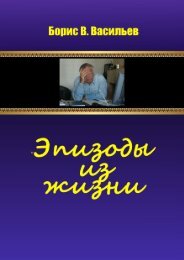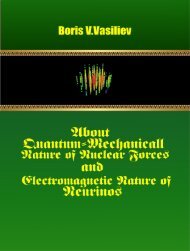VbvAstE-001
Book Boris V. Vasiliev Astrophysics
Book Boris V. Vasiliev
Astrophysics
Create successful ePaper yourself
Turn your PDF publications into a flip-book with our unique Google optimized e-Paper software.
Chapter 8<br />
The angular velocity of the<br />
apsidal rotation in binary<br />
stars<br />
8.1 The apsidal rotation of close binary stars<br />
The apsidal rotation (or periastron rotation) of close binary stars is a result of their<br />
non-Keplerian movement which originates from the non-spherical form of stars. This<br />
non-sphericity has been produced by rotation of stars around their axes or by their<br />
mutual tidal effect. The second effect is usually smaller and can be neglected. The<br />
first and basic theory of this effect was developed by A.Clairault at the beginning of<br />
the XVIII century. Now this effect was measured for approximately 50 double stars.<br />
According to Clairault’s theory the velocity of periastron rotation must be approximately<br />
100 times faster if matter is uniformly distributed inside a star. Reversely,<br />
it would be absent if all star mass is concentrated in the star center. To reach an<br />
agreement between the measurement data and calculations, it is necessary to assume<br />
that the density of substance grows in direction to the center of a star and here it runs<br />
up to a value which is hundreds times greater than mean density of a star. Just the<br />
same mass concentration of the stellar substance is supposed by all standard theories<br />
of a star interior. It has been usually considered as a proof of astrophysical models.<br />
But it can be considered as a qualitative argument. To obtain a quantitative agreement<br />
between theory and measurements, it is necessary to fit parameters of the stellar<br />
substance distribution in each case separately.<br />
Let us consider this problem with taking into account the gravity induced electric<br />
polarization of plasma in a star. As it was shown above, one half of full mass of a<br />
star is concentrated in its plasma core at a permanent density. Therefor, the effect<br />
61













